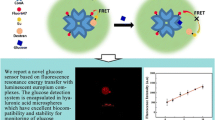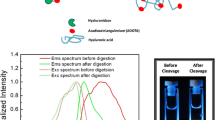Abstract
Due to its important role in tumor development and treatment, hyaluronidase (HAase) has been widely investigated in vitro and in vivo. However, such investigation was limited by the absence of sensitive and in situ detection methods. Herein, a hyaluronic acid (HA) hydrogel based on the fluorescence resonance energy transfer (FRET) effect was constructed for the detection of HAase. FITC and AuNPs were covalently coupled with two HA derivatives respectively to form a fluorescent donor-acceptor pair. In the presence of HAase, the hydrogel established by cross-linking of HA derivatives was hydrolyzed specifically. The FRET effect in the hydrogel disappeared and the fluorescence intensity increased proportionally with the changes in the concentration of the HAase. Experiments proved that the HAase sensing system had a wide response range (0.5–100 U/mL), good anti-interference, and excellent biocompatibility. When the hydrogel was used for 3D culture of lung cancer cells, in situ fluorescent response could be achieved.

Graphical abstract








Similar content being viewed by others
References
Kolliopoulos C, Bounias D, Bouga H, Kyriakopoulou D, Stavropoulos M, Vynios DH. Hyaluronidases and their inhibitors in the serum of colorectal carcinoma patients. J Pharm Biomed Anal. 2013;83:299–304.
Lokeshwar V, Rubinowicz D. Hyaluronic acid and hyaluronidase: molecular markers associated with prostate cancer biology and detection. Prostate Cancer Prostatic Dis. 1999;2:S21–S.
Hautmann SH, Lokeshwar VB, Schroeder GL, Civantos F, Duncan RC, Gnann R, et al. Elevated tissue expression of hyaluronic acid and hyaluronidase validates the HA-HAase urine test for bladder cancer. J Urol. 2001;165(6):2068–74.
Liu R, Xiao W, Hu C, Xie R, Gao HL. Theranostic size-reducible and no donor conjugated gold nanocluster fabricated hyaluronic acid nanoparticle with optimal size for combinational treatment of breast cancer and lung metastasis. J Control Release. 2018;278:127–39.
Franzmann EJ, Schroeder GL, Goodwin WJ, Weed DT, Fisher P, Lokeshwar VB. Expression of tumor markers hyaluronic acid and hyaluronidase (HYAL1) in head and neck tumors. Int J Cancer. 2003;106(3):438–45.
Chib R, Mummert M, Bora I, Laursen BW, Shah S, Pendry R, et al. Fluorescent biosensor for the detection of hyaluronidase: intensity-based ratiometric sensing and fluorescence lifetime-based sensing using a long lifetime azadioxatriangulenium (ADOTA) fluorophore. Anal Bioanal Chem. 2016;408(14):3811–21.
Singh M, Mukundan S, Jaramillo M, Oesterreich S, Sant S. Three-dimensional breast cancer models mimic hallmarks of size-induced tumor progression. Cancer Res. 2016;76(13):3732–43.
Seliktar D. Designing cell-compatible hydrogels for biomedical applications. Science. 2012;336(6085):1124–8.
Tang YD, Huang BX, Dong YQ, Wang WL, Zheng X, Zhou W, et al. Three-dimensional prostate tumor model based on a hyaluronic acid-alginate hydrogel for evaluation of anti-cancer drug efficacy. J Biomater Sci Polym Ed. 2017;28(14):1603–16.
Taubenberger AV, Bray LJ, Haller B, Shaposhnykov A, Binner M, Freudenberg U, et al. 3D extracellular matrix interactions modulate tumour cell growth, invasion and angiogenesis in engineered tumour microenvironments. Acta Biomater. 2016;36:73–85.
David L, Dulong V, Le Cerf D, Chauzy C, Norris V, Delpech B, et al. Reticulated hyaluronan hydrogels: a model for examining cancer cell invasion in 3D. Matrix Biol. 2004;23(3):183–93.
Wasteson A. Properties of fractionated chondroitin sulphate from ox nasal septa. Biochem J. 1971;122(4):477–&.
Diferrante N. Turbidimetric measurement of acid mucopolysaccharides and hyaluronidase activity. J Biol Chem. 1956;220(1):303–6.
Nossier AI, Eissa S, Ismail MF, Hamdy MA, Azzazy HME. Direct detection of hyaluronidase in urine using cationic gold nanoparticles: a potential diagnostic test for bladder cancer. Biosens Bioelectron. 2014;54:7–14.
Magalhaes MR, da Silva NJ, Ulhoa CJ. A hyaluronidase from Potamotrygon motoro (freshwater stingrays) venom: isolation and characterization. Toxicon. 2008;51(6):1060–7.
Bailey LC, Levine NA. Optimization of the usp assay for hyaluronidase. J Pharm Biomed Anal. 1993;11(4–5):285–92.
Xie HF, Zeng F, Wu SZ. Ratiometric fluorescent biosensor for hyaluronidase with hyaluronan as both nanoparticle scaffold and substrate for enzymatic reaction. Biomacromolecules. 2014;15(9):3383–9.
Liu SY, Zhao N, Cheng Z, Liu HG. Amino-functionalized green fluorescent carbon dots as surface energy transfer biosensors for hyaluronidase. Nanoscale. 2015;7(15):6836–42.
Chen M, Yin H, Bai P, Miao P, Deng X, Xu Y, et al. ABC transporters affect the elimination and toxicity of CdTe quantum dots in liver and kidney cells. Toxicol Appl Pharmacol. 2016;303:11–20.
Tian J, Hu J, Liu G, Yin H, Chen M, Miao P, et al. Altered gene expression of ABC transporters, nuclear receptors and oxidative stress signaling in zebrafish embryos exposed to CdTe quantum dots. Environ Pollut. 2019;244:588–99.
Luo Y, Kirker KR, Prestwich GD. Cross-linked hyaluronic acid hydrogel films: new biomaterials for drug delivery. J Control Release. 2000;69(1):169–84.
Jia XQ, Colombo G, Padera R, Langer R, Kohane DS. Prolongation of sciatic nerve blockade by in situ cross-linked hyaluronic acid. Biomaterials. 2004;25(19):4797–804.
Su HC, Ma Q, Shang K, Liu T, Yin HS, Ai SY. Gold nanoparticles as colorimetric sensor: a case study on E. coli O157:H7 as a model for Gram-negative bacteria. Sens Actuators B Chemical. 2012;161(1):298–303.
Ma L, Gao WJ, Han X, Qu FL, Xia L, Kong RM. A label-free and fluorescence turn-on assay for sensitive detection of hyaluronidase based on hyaluronan-induced perylene self-assembly. NJCh. 2019;43(8):3383–9.
Liu W, Ding F, Wang Y, Lu Z, Zou P, Wang X, et al. A dual-readout nanosensor based on biomass-based C-dots and chitosan@AuNPs with hyaluronic acid for determination of hyaluronidase. Luminescence. 2019.
Ge M, Bai P, Chen M, Tian J, Hu J, Zhi X, et al. Utilizing hyaluronic acid as a versatile platform for fluorescence resonance energy transfer-based glucose sensing. Anal Bioanal Chem. 2018;410(9):2413–21.
Liang F, Pan T, Sevick-Muraca EM. Measurements of FRET in a glucose-sensitive affinity system with frequency-domain lifetime spectroscopy. Photochem Photobiol. 2005;81(6):1386–94.
Drury JL, Mooney DJ. Hydrogels for tissue engineering: scaffold design variables and applications. Biomaterials. 2003;24(24):4337–51.
Wu D, Shi XG, Zhao FL, Chilengue STF, Deng LD, Dong AJ, et al. An injectable and tumor-specific responsive hydrogel with tissue-adhesive and nanomedicine-releasing abilities for precise locoregional chemotherapy. Acta Biomater. 2019;96:123–36.
Ge J, Cai R, Yang L, Zhang LL, Jiang Y, Yang Y, et al. Core-shell HA-AuNPs@SiNPs nanoprobe for sensitive fluorescence hyaluronidase detection and cell imaging. ACS Sustain Chem Eng. 2018;6(12):16555–62.
Yang WQ, Ni JC, Luo F, Weng W, Wei QH, Lin ZY, et al. Cationic carbon dots for modification-free detection of hyaluronidase via an electrostatic-controlled ratiometric fluorescence assay. AnaCh. 2017;89(16):8384–90.
An LL, Liu LB, Wang S. Cationic conjugated polymers for homogeneous and sensitive fluorescence detection of hyaluronidase. Sci China Ser B Chem. 2009;52(6):827–32.
Lee H, Lee K, Kim IK, Park TG. Synthesis, characterization, and in vivo diagnostic applications of hyaluronic acid immobilized gold nanoprobes. Biomaterials. 2008;29(35):4709–18.
Gu W, Yan YH, Zhang CL, Ding CP, Xian YZ. One-step synthesis of water-soluble MoS2 quantum dots via a hydrothermal method as a fluorescent probe for hyaluronidase detection. ACS Appl Mater Interfaces. 2016;8(18):11272–9.
Wei H, Li B, Li J, Wang E, Dong S. Simple and sensitive aptamer-based colorimetric sensing of protein using unmodified gold nanoparticle probes. Chem Commun. 2007;36:3735–7.
Pem B, Pongrac IM, Ulm L, Pavicic I, Vrcek V, Jurasin DD, et al. Toxicity and safety study of silver and gold nanoparticles functionalized with cysteine and glutathione. Beilstein J Nanotechnol. 2019;10:1802–17.
Suo A, Xu W, Wang Y, Sun T, Ji L, Qian J. Dual-degradable and injectable hyaluronic acid hydrogel mimicking extracellular matrix for 3D culture of breast cancer MCF-7 cells. Carbohydr Polym. 2019;211:336–48.
Aref AR, Huang RYJ, Yu WM, Chua KN, Sun W, Tu TY, et al. Screening therapeutic EMT blocking agents in a three-dimensional microenvironment. Integr Biol. 2013;5(2):381–9.
Bourguignon LYW, Singleton PA, Diedrich F, Stern R, Gilad E. CD44 interaction with Na+-H+ exchanger (NHE1) creates acidic microenvironments leading to hyaluronidase-2 and cathepsin B activation and breast tumor cell invasion. J Biol Chem. 2004;279(26):26991–7007.
Berger JT, Voynow JA, Peters KW, Rose MC. Respiratory carcinoma cell lines - MUC genes and glycoconjugates. Am J Respir Cell Mol Biol. 1999;20(3):500–10.
Jacobson A, Rahmanian M, Rubin K, Heldin P. Expression of hyaluronan synthase 2 or hyaluronidase 1 differentially affect the growth rate of transplantable colon carcinoma cell tumors. Int J Cancer. 2002;102(3):212–9.
Lokeshwar VB, Rubinowicz D, Schroeder GL, Forgacs E, Minna JD, Block NL, et al. Stromal and epithelial expression of tumor markers hyaluronic acid and HYAL1 hyaluronidase in prostate cancer. J Biol Chem. 2001;276(15):11922–32.
Lokeshwar VB, Obek C, Pham HT, Wei D, Young MJ, Duncan RC, et al. Urinary hyaluronic acid and hyaluronidase: markers for bladder cancer detection and evaluation of grade. J Urol. 2000;163(1):348–56.
Zhang L, Cui H. HAase-sensitive dual-targeting irinotecan liposomes enhance the therapeutic efficacy of lung cancer in animals. Nanotheranostics. 2018;2(3):280–94.
Pandit AH, Mazumdar N, Ahmad S. Periodate oxidized hyaluronic acid-based hydrogel scaffolds for tissue engineering applications. Int J Biol Macromol. 2019;137:853–69.
Funding
The author(s) disclosed receipt of the following financial support for the research, authorship, and/or publication of this article: This work was funded and supported by grants from National Natural Science Foundation of China (No. 21876198), National Science and Technology Major Project of China (2017ZX10302301-003), National Key R&D Program of China (2017YFF0108600), and Natural Science Foundation of Shandong Province (ZR2019QB021).
Author information
Authors and Affiliations
Corresponding authors
Ethics declarations
Conflict of interest
The authors declare that they have no conflicts of interest.
Additional information
Publisher’s note
Springer Nature remains neutral with regard to jurisdictional claims in published maps and institutional affiliations.
Electronic supplementary material
ESM 1
(PDF 451 kb)
Rights and permissions
About this article
Cite this article
Ge, M., Sun, J., Chen, M. et al. A hyaluronic acid fluorescent hydrogel based on fluorescence resonance energy transfer for sensitive detection of hyaluronidase. Anal Bioanal Chem 412, 1915–1923 (2020). https://doi.org/10.1007/s00216-020-02443-9
Received:
Revised:
Accepted:
Published:
Issue Date:
DOI: https://doi.org/10.1007/s00216-020-02443-9




